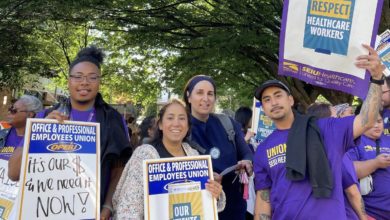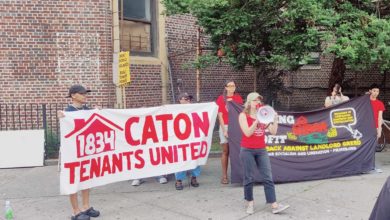On Dec. 7, San Francisco police shot a homeless man in the ever-gentrifying Mission District. Despite eyewitness accounts contesting SFPD’s version of the incident, local corporate media immediately published such headlines as “SF police shoot burglary suspect.” They quoted heavily from local business owners who praised the police and decried the presence of homeless people in the neighborhood.
The Mission District, an historically working-class, multinational neighborhood, has seen its residents pushed out of the city and, in some cases, onto the streets as the cost of housing has skyrocketed. A one-bedroom apartment can rent for as much as $4,000 a month there now.
Across the Bay Area, tech companies proliferate and housing profiteers abound. The homeless population in San Francisco has risen by 30 percent these past two years. Across the bay in Oakland, the percentage of unhoused people has nearly doubled.
As the crisis deepens, local and federal governments have responded with aggressive sweeps and criminalizing homeless people and their activities. Yet, they have done little to materially address the problem. Over-priced units sit vacant while people sleep on the streets. On any given night in SF, the shelter wait list hovers around 1,000. Simultaneously, politicians, the corporate media, and business leaders encourage growing animosity toward the unhoused.
Liberals share responsibility
In September, Trump traveled to California to fund-raise and pay a visit to the border wall. He attacked the Democratic leadership over the ever-growing population of homeless people in the Bay Area and Los Angeles, with comments ranging from the bigoted to the ridiculous. Voices from “The Resistance,” politicians and locals alike, publicly denounced his comments. But many of these liberal políticians are responsible for the growing aggression themselves. Governor Gavin Newsom, while mayor of San Francisco, initiated numerous policies criminalizing panhandling and making life on the streets even harder.
The San Francisco Chronicle, the city’s leading newspaper and voice of the ruling class, featured headlines such as “Trump was right about SF homeless of course. Then he blew it” and “President Trump is both right and wrong about California homelessness.” Corporate media outlets in the Bay Area paint a dismal picture of feces, needles, and all around filth and crime in the streets. They completely neglect the humanity of the people forced to live in these subhuman conditions and the policies that have led to this state.
A sector of SF residents, whose class affiliation and living conditions are deeply divorced from the challenges of poorer working people in the region, exhibit much the same attitude. Individuals have physically attacked homeless people. Neighbors and small business owners have banded together to place boulders on sidewalks and wall off alleyways to prevent the unhoused from finding a place to sleep.
Over the summer, wealthy residents made headlines for crowdfunding over $100,000 to hire infamous eviction lawyer Andrew Zacks to halt the construction of a homeless shelter in their neighborhood. They relied on tired anti-poor tropes, claiming the shelter would bring crime, drugs and filth to the area. They also attempted to halt the shelter on environmental grounds, taking a page out of Trump’s playbook when he made the ridiculous claim that homeless people were destroying the planet by littering the Pacific Ocean with thousands of needles.
Behind progressive facade
San Francisco is showing that behind its progressive facade is a city bent on ridding itself of the poorest among us. They’ve misplaced the blame for rows of tents, scattered needles, human waste on sidewalks, open air drug markets, and all the conditions that were described by UN rapporteur Leilani Farha as “third world” on homeless people themselves. Instead, the blame should be squarely placed on policies that have done little to nothing to address the growing housing crisis and that deny such basic essentials as public bathrooms or critical mental health and rehabilitation services. San Franciscans are falling into a trap set by the wealthy and their friends in City Hall to make the problem disappear.
This rising tide of reaction against the poor is a danger that sets itself up to support the more extreme measures being proposed by local and state politicians. Trump raised concern among Californians during his visit when he suggested homeless encampments be razed and “facilities” built in their place. For advocates of the homeless, these proposed facilities evoke the current concentration camps caging immigrants at the border. For Bay Area and state politicians feigning outrage over these comments, however, their proposals to address the homeless crisis have not been much different. Some have promoted re-purposing closed jails, military-style tents, or rural ranches to warehouse the homeless population.
The statewide expansion of conservatorship guidelines falls in a similar vein. Last year, the California legislature passed a pilot program for major cities to opt into, expanding the eligibility of mentally ill and drug addicted people to be stripped of their civil liberties and forced into treatment for long periods until a judge rules the person self-sufficient and free to go. Homeless advocates immediately saw this measure for what it was: an attempt to take more homeless people out of the public eye and lock them away.
Out of the three cities that debated participating in this trial — San Diego, Los Angeles, and San Francisco — only the latter voted in favor. It should be noted that San Francisco has struggled with providing psychiatric bed space, and people who are currently conserved can find themselves kept in high-security psych wards long after being deemed self-sufficient and not a harm to society, due to medium- and low-security beds being kept intentionally vacant. And to be conserved under this expansion, one must first meet a minimum number of temporary psychiatric holds initiated by the police, in a country where people with serious mental health conditions are 16 times more likely than the average person to be killed in police encounters.
Making life more difficult
While these proposals are debated and fleshed out, other policies that have existed for years continue to make life more difficult for the homeless. San Francisco Mayor London Breed announced in November the start of this year’s “Love Our City Holiday Eco Blitz,” a program that has brought daily sidewalk power washes and other “improvements” to the city’s busiest streets. To make way for holiday shoppers and in the midst of heavy rain storms, unhoused people are facing increased sweeps, with police and city sanitation workers confiscating tents and belongings and either “bagging and tagging” them in hard-to-access storage facilities or simply throwing them into a trash compactor. Mayor Breed boasted over the summer that under her leadership, the number of tents lining the city’s sidewalks decreased by 33 percent, in no way acknowledging that the number did not correlate with fewer people living on the streets, but rather with “progressive” California Senator (then city supervisor) Scott Weiner championing Proposition Q, an anti-tent ordinance, in 2016.
The call for more police officers flooding impoverished neighborhoods also continues, supported especially by small business owners and wealthy tech workers. In incidents involving the unhoused, including overdoses and mental health crises, police are typically the first on the scene, responding with violence and further trauma for the victims.
Even seemingly compassionate measures do not strike at the root of the problem. In a recent televised roundtable discussion with the mayors of Oakland, San Jose, and Berkeley, they insist repeatedly on having to “build themselves out of the housing crisis.” The problem is presented as a lack of supply of affordable housing. And while there is undoubtedly an affordability crisis, is more construction really the solution?
“There’s no ‘housing crisis,’” Mike, with the Coalition on Homelessness, tells Liberation News. He works with the non-profit in SF’s Tenderloin District, the neighborhood most impacted by homelessness in the city, organizing and working directly with the unhoused. “Everything is vacant, all those condos they built.” For every homeless person in San Francisco alone, there are roughly five vacant units, with more market rate and luxury units in the works daily. For all its proposed “solutions” to the crisis of homelessness, the San Francisco Bay Area, and the state of California at large, is not willing to sacrifice real-estate investments to ensure housing for all. Mike says, “But of course, you give somebody [housing] that’s considered socialism. So what?”
Housing a commodity
Under capitalism, housing is a commodity, built to sell or lease at the highest price, with only minute fractions reserved as “affordable” or below market rate — and only as a concession to the hard-fought demands of working-class communities and housing-rights advocates. Socialism is the real solution to the crisis of homelessness because it is not a system centered around profit. When an economy is planned around meeting human needs, there is no sensible reason for thousands of people to sleep in tents or cars or on cold, wet concrete, with luxury housing projects being erected all around them. Capitalism can never guarantee the basic necessities of life to every person.
Local capitalist propaganda is doing its best to obscure this truth. Frank Somerville, local Channel 2 KTVU reporter, pointedly asks Bay Area mayors during the roundtable discussion: “Do we hit a tipping point? Everyone wants to be compassionate, but at some point, are people gonna say essentially enough is enough?” While the mayors initially responded with rehearsed heartwarming stories about individual homeless people they’ve met, they followed up with talking about “compassion fatigue” and making clear that “the law is the law,” and moving the discussion in a right-wing direction. At the end of the day, the local ruling class and their media counterparts get away with presenting a degree of humanity for the cameras, while continuing to enact and defend their inhumane anti-poor policies in the streets.
Dehumanizing narratives about the homeless are a tactic to undercut the immense potential for solidarity and struggle, and must be rejected at every turn. Housing is a human right, regardless of employment status, mental health, or addiction. It is a right that alongside health care, a job, education, and access to food must be fought for.
No to the dehumanization of the homeless! Yes to housing for all!





